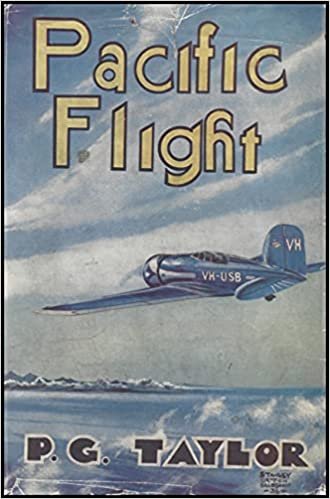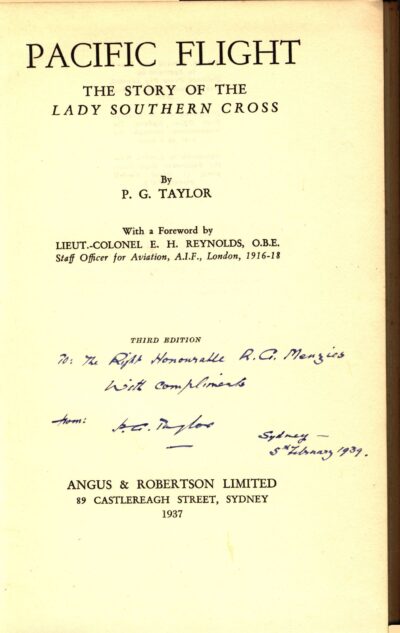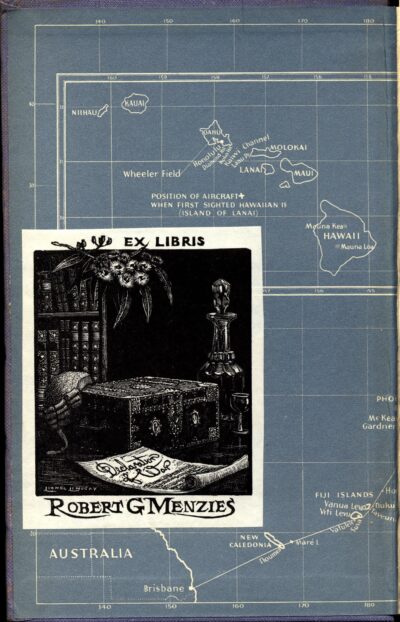P.G. Taylor, Pacific Flight: The Story of the Lady Southern Cross (1937)
Sir Patrick Gordon Taylor was one of the pioneering heroes of Australian aviation. Born in Mosman NSW in 1896, from an early age Taylor exhibited an adventurous spirit which saw him take a dinghy out to explore the uninhabited islands of Pittwater Bay. Graduating school just as the First World War broke out, he tried to enlist with the fledgling Australian Flying Corps but was rejected. Instead, he went to Britain and joined the Royal Flying Corps, proving himself to be an ace through 40 combat missions over France, winning the Military Cross in July 1917, and earning promotion to captain.
Returning to Australia after the war, Taylor continued to pursue a career in aviation. During the 1930s he served as navigator for record breaking flights by legendary pilots Charles Kingsford Smith and Charles Ulm. These included the first commercial flight between Australia and New Zealand, a round trip to England, and the first flight from Australia to the United States.
Pacific Flight is a first-hand account of one of Taylor’s flights with Kingsford Smith which went awry. On 15 May 1935 the two men were flying in the Southern Cross for the King George V jubilee airmail flight between Australia and New Zealand. Halfway across the Tasman Sea, part of the centre engine’s exhaust manifold broke off and severely damaged the starboard propeller. Kingsford Smith was forced to close down the vibrating starboard engine, jettison the flight’s cargo, and turn back for Australia.
As the oil pressure on the port engine began to fall alarmingly, Taylor had to climb out of the fuselage, and edge his way along the wing to collect oil from the disabled starboard engine to be transferred to the jeopardised port engine. He had to do this six times before the aircraft landed safely at Mascot some nine hours later. Taylor was later rewarded with the Empire Gallantry Medal for saving the aircraft and the lives of those on board. The heroic scenes would also be recreated in the 1946 film Smithy.
Menzies seems to have been quite well acquainted with Taylor, as the Menzies Collection contains four of his books, all with personal inscriptions. Pacific Flight was the first, gifted on 5 February 1939, when Menzies was still serving as Attorney-General in the Lyons Government.
In 1950, when Menzies was Prime Minister, the Commonwealth Government gave Taylor approval to chart out an air route between Australia and South America for Qantas, loaning him an RAAF flying boat for the journey. Menzies wrote Taylor a personal letter of introduction to give to the Chilean President, and Air Minister Thomas White boasted that the Australian was the world’s greatest living airman.
The 8500 journey proved perilous, and on Taylor’s safe return Menzies hailed his courage and his efforts to improve safety for commercial flying (Menzies himself had a strong personal experience of the dangers of flight, as he had lost several dear friends and colleagues in the Canberra Air Disaster of 1940). As a reward for Taylor’s exploits, Menzies gifted him the aircraft he had used on the mission, dubbed the ‘Frigate Bird II’. In 1962 Taylor returned the favour, regifting the Frigate Bird II to the NSW Government as a museum piece. It now hangs with pride of place as the centre-piece of the Transport Gallery of the Powerhouse Museum in Sydney.
You might also like...
Sign up to our newsletter
Sign up for our monthly newsletter to hear the latest news and receive information about upcoming events.




